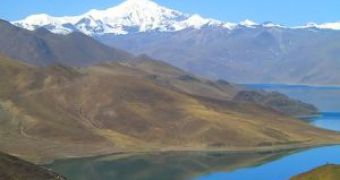At the current global warming rate, 30% of the world's highest glaciers will be gone by 2050 and by 2090, 50% will be history. The melting of Tibet's massive glaciers will have a deep impact on south and southeastern Asia, but for the people inhabiting the region this remains a vague concept.
Even at the coldest points, like around the Nojin Kangtsang glacier between the regional capital of Lhasa and Mount Everest, which reaches a height of 7,191 meters (23,592 feet), there are signs of warming, like the waters of Yamdrok-So lake, with their deep turquoise, a color pointing to winter ice melts.
In 2007, the melting occurred early due to the warmer temperatures of January and February, and where normally there is a thick layer of snow all around, now only small patches of snow and ice can be seen on the surrounding mountains. "Under the influence of global warming, the climate on the Tibetan Plateau has seen significant changes over the last three years," said Xu Liangyan, an engineer at the China Meteorological Bureau.
2006 has been the warmest year in China since 1951, and the Tibetan plateau, at almost 5,000 meters (15,000 feet) above sea level, recorded the highest rise in temperatures. "It is obvious that the glacial melt is accelerating and the snow line has been retreating," said Kang Shichang, an expert at the Institute of Tibetan Plateau Research at the Chinese Academy of Sciences. "Apart from that, wetlands are shrinking and water storage tables are falling."
"The temperature in the western part of the Tibetan plateau throughout this winter was between two and four degrees Celsius (35.6-39.2 degrees Fahrenheit) higher than average", said Song Yanling an official at the meteorological bureau.
Tibet is the source of some of the Asia's greatest rivers, like the Brahmaputra, Yangtze, Yellow and Mekong, feeding almost 3 billion people, directly threatened in case of water shortages. 300 million farmers in western China would be severely affected by water shortages from lower volumes coming down from the reduced glaciers. However, for the moment, locals do not see the danger. "The end of 2006 was difficult and we had a lot of snow," said Quesan, a farmer and head of Hamu village on the banks of the Yamdrok-So. "The people here work on small pieces of land and are raising only a few head of livestock."
Locals are largely ignorant about the outside world and how its energy-intensive life will affect Tibet's traditional lifestyle. "No one is destroying anything," he said. "There was a lot of snow here just several weeks ago and you could walk across the lake," said Tunju, shepherd over 100 sheep for Hamu village and earning seven yuan (90 US cents) daily. "I have noticed that we have had a lot of snow recently," said a young woman, who raises yaks and sells tourist books as part of a small community in the Karo-La pass.

 14 DAY TRIAL //
14 DAY TRIAL //